 By Bob Currie, Recreational Boating Safety Specialist
By Bob Currie, Recreational Boating Safety Specialist
U.S. Coast Guard Auxiliary Station Galveston Flotilla
Like many of you, I am the outdoorsy type, and welcome new experiences. I have almost always had a powerboat, but when I began to see more and more kayaks on my local lake, I decided to see what it was all about, and began researching kayaks and kayaking in general. I went to the big box store and found that I could get into kayaking for a mere $200, albeit as basic a model as you could get. I am talking about a sit on top (SIT), molded seat version with no storage hatches.
The Station Galveston Flotilla of the US Coast Guard Auxiliary operates out of the USCG Station Galveston base on Galveston Island. They aid the Coast Guard by providing maritime observation patrols in Galveston Bay; by providing recreational boating vessel safety checks; and by working alongside Coast Guard members in maritime accident investigation, small boat training, providing a safety zone, Aids to Navigation verification, in the galley, and watch standing.
Some people might go to the other extreme and get the kayak version that had all the equipment including a galley and air-conditioned stateroom. But I am a firm believer in the Half Rule, which says that once you buy something, the most you can get for it if you decide to sell it is half what you paid for it. That rule was operational when I decided to move up to a higher class of kayak. I sold that basic model for $100.
The Paddle
As a former Boy Scout, I was the proud recipient of the Canoeing Merit Badge. That meant that at one time I was proficient with a paddle and could maneuver a canoe anywhere I wanted to go, using the proper strokes to go in the direction I wanted to go. I knew that knowledge was going to be useful, but I also knew that there would be some learning required as the kayak paddle has two blades instead of one. The required J-stroke for canoes would be useless on the kayak. In my excitement at buying my first kayak, I left the store without purchasing a paddle. That actually gave me a little time to research kayak paddles. The price range seemed to be anywhere from $30 to $300. I asked the usual “which is the best, which will work,” questions and settled on a paddle that cost in the $80-100 range. Let’s look at some of the considerations, as the paddle is your means of propulsion and is quite important.
The basic considerations when choosing a paddle are:
- Activity
- Length
- Blade material
- Blade shape
- Shaft materials
- Straight or bent shaft
- Feathered or matched blades
Activity
The first consideration when buying a paddle is what type of activity will it be used for. Are you going to be touring a river, lake, or bay; will you be kayak fishing; or will you be whitewater kayaking? There are different recommendations based on your activity and how you want to perform those activities. Do you want to do a slow cruise? If so, a low angle blade gives you a relaxed body position and allows you to use moderate energy for a leisurely pace. Do you want to have high efficiency and performance? Then a high angle blade would suit you.
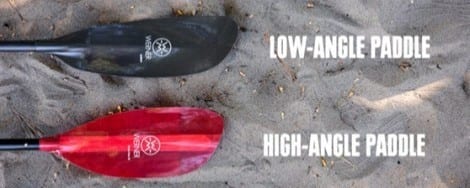
Length
The length of your paddle is one of the most important considerations. If the paddle is too short you will be banging the side of your kayak when trying to paddle. If the length is too long, your paddle blades will be striking the water so far from the side of the kayak that your kayak will be yawing from side to side rather than tracking straight ahead. Manufacturers have length recommendation charts. Below is the chart for Werner paddles. I have also used pictures from their website for illustration purposes.

Ideally you should be able to exchange a paddle after trying it and finding the length doesn’t work for you, so ask that question if you are unsure about the length.
Blade Material
When you are first starting out, blade material isn’t that important, especially if you are on a limited budget. There are three basic blade material choices:
- Plastic/Nylon- lowest price, but less efficient due to the flexibility of the blades.
- Fiberglass: middle price range, more efficient and lighter weight.
- Carbon-fiber: highest price, ultra-light and ultra-stiff for excellent energy transfer.
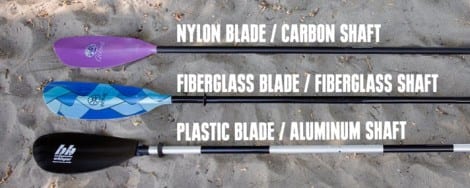
As you can see from the picture, there are many different combinations of blade and shaft materials. The lighter the blade and shaft, and the stiffer the blade, the more efficient the paddle becomes. That increase in efficiency also comes with an increase in price, though.
Blade Shape
Most blades now have an asymmetrical shape (relatively narrow and shorter on one side) that angles it so the surface area of the blade is more uniform when pushing through water. When paddling, one pushes the paddle blades through the air more than one pushes the blades through the water, and even when coasting a large-area blade can act as a drag through the air and cause a loss of efficiency. For that reason, kayak paddles have evolved from big flat blades to narrow blades with a design to make the most of the time the blade is pushing through the water.
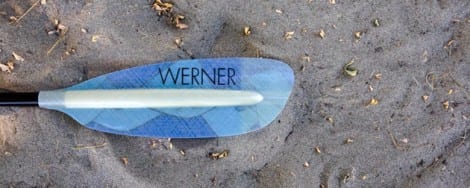
Shaft Materials
The type of shaft material you choose can add to both the efficiency of the paddle as well as its price. Aluminum is the cheapest shaft material. Although it is lightweight, in bright sunlight it can become hot to handle, so be sure to wear some gloves if you choose an aluminum shaft paddle. Fiberglass and carbon-fiber shafts are even lighter, and paddling with a light paddle is much easier than paddling with a heavier paddle, especially after a few hundred strokes. Expect to pay more for the upgrade to fiberglass or carbon-fiber.
Straight or Bent Shaft
Bent shafts have a kinked section that positions your hands at a more comfortable handle. The stress on the wrists with a straight shaft can become painful not only during the trip, but over time as the wear and tear on your tendons and ligaments becomes cumulative. That said, the energy transfer when using a straight shaft is more direct, and the blade angle is easier to change with a straight shaft.
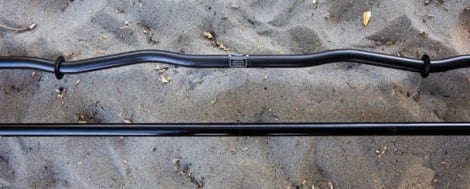
Feathered or Matched Blades
Matched blades are aligned with each other. Feathered blades are not on the same plane. The advantage of feathered blades is reduced wind resistance. Most two-piece shaft paddles have three positions in which you can join the shaft. The center position results in the blade angles being matched. The other two positions result in the blades being feathered. You can experiment around with which way you want the blades to be angled, and you may want to change the position during your trip to relieve tension on one or both wrists. A push of a spring-loaded button is all it takes to change the blade angles.
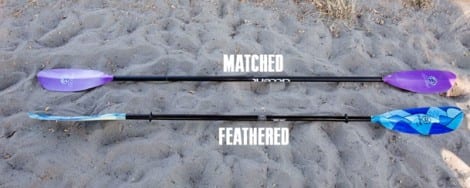
Summary
Have you ever gone to a burger place and spent three minutes describing how you wanted your burger, then said, “and add a side of fries,” only to have the waitperson say, “fat cut, skinny cut, crinkled cut, waffle cut, seasoned or unseasoned?” Turns out you had some more thinking to do before you could complete your order. It’s like that when buying a kayak and adding a paddle to the order. You need to put a lot more thought into that paddle purchase than you realize. Make the right choice and you will have a much more enjoyable trip on the water.
For more information on boating safety, please visit the Official Website of the U.S. Coast Guard’s Boating Safety Division at www.uscgboating.org. Questions about the US Coast Guard Auxiliary or our free Vessel Safety Check program may be directed to me at [email protected]. SAFE PADDLING!
[May-18-2020]

 Posted in
Posted in 























